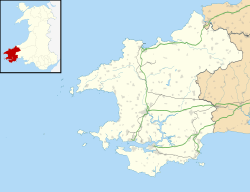| Mynachlog-ddu | |
|---|---|
 Bethel Chapel, Mynachlog-ddu | |
Location within Pembrokeshire | |
| Population | 494 (2011) [1] |
| OS grid reference | SN 14 30 |
| • Cardiff | 72.8 mi (117.2 km) |
| • London | 198.2 mi (319.0 km) |
| Community |
|
| Principal area | |
| Country | Wales |
| Sovereign state | United Kingdom |
| Post town | Clunderwen |
| Postcode district | SA66 |
| Police | Dyfed-Powys |
| Fire | Mid and West Wales |
| Ambulance | Welsh |
| UK Parliament | |
| Senedd Cymru – Welsh Parliament | |
Mynachlog-ddu ( SN143306 ) is a village, parish and community in the Preseli Hills, Pembrokeshire, Wales. The community includes the parish of Llangolman.



